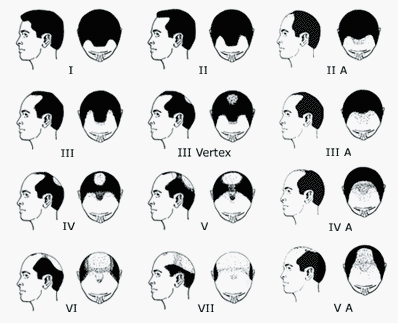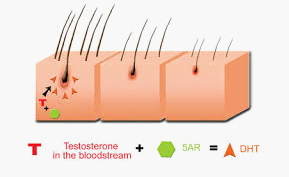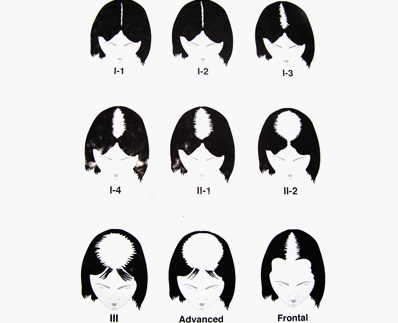About Male Pattern Hair Loss
Human beings are born with approximately 100,000 hair follicles. On average, 20 percent of males would start losing their hair in their 20s, 40 percent would have lost hair (to some degree) in their forties and 60 percent in their 60s and above.
Each hair follicle is an individual unit and responds differently to hormones, stresses, environmental factors and genes. Hair loss is mainly hereditary (determined by your genes), and other factors can accelerate or slow this hair loss.
Unless you traumatise the hair follicle( Injury etc), when the time comes your hair becomes sensitive to the normal male hormone called Testosterone. However, this hormone has to be activated into its active form called Dihydrotestosterone (DHT) with the help of an enzyme called 5 alpha-reductase. When the hair follicle is repeatedly exposed to DHT, it spends little time gowing and exhausts all its cycles of growth quickly. Normally a hair would grow for 3 to 10 years (this stage is Anagen), then stops growing for 2 to 3 weeks ( this is Catagen), before entering the resting stage for 3-4 months where it gradually becomes thinner before falling (called Telogen) and then the new hair grows. Each hair goes through this cycle between 10 and 20 times. If the cycles are quick or fast, then one would expect to lose hair at a younger age. Exposure to DHT and the genetic predisposition to hair loss would determine how quick and how much one loses hair.
Refer to the picture on the right hand side and see where you are on the Nowood scale.


Female Pattern Hair Loss
Upto 30% of females would expect some degree of hair loss or thinning in their lifetime. Similar to male pattern baldness, the cause is mainly genetic. But other factors also play a role in their hair loss. These may be
- Poor nutrition
- chemotherapy
- anaemia
- thyroid illnesses
- post pregnancy
- hormonal imbalances
- postmenopausal
- surgical or trauma related stresses
- skin conditions
- and certain hairstyles like traction alopecia
- Before any female is treated, non genetic causes of hair loses must be excluded.
Refer to the Lludwig chart on the right hand side and see where you are on scale. It will give you some idea as to what treatment may be suitable for you.

